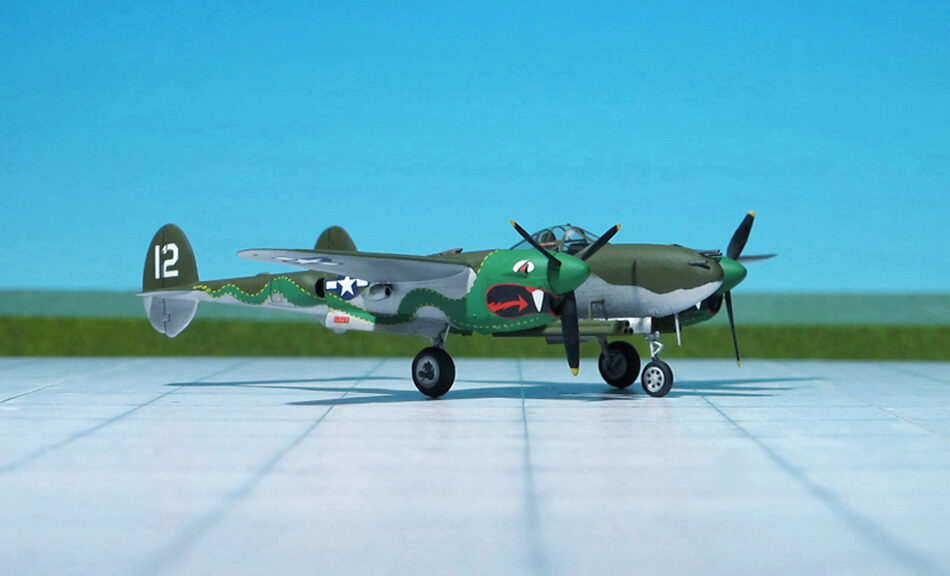TYPE: Fighter, Fighter bomber
ACCOMMODATION: Pilot only
POWER PLANT: Two Allison V-1710 (-89 left hand rotation and -91 right hand rotation) liquid-cooled turbo-supercharged piston engine, rated at 1,425 hp each at 26,000 ft
PERFORMANCE: 420 mph
COMMENT: The Lockheed P-38 Lightning was an American single-seat, twin piston-engined fighter aircraft that was used during World War II. Developed for the United States Army Air Corps (USAAC) by the Lockheed Corporation, the P-38 incorporated a distinctive twin-boom design with a central nacelle containing the cockpit and armament. Along with its use as a general fighter, the P-38 was used in various aerial combat roles, including as a highly effective fighter-bomber, a night-fighter, and a long-range escort fighter when equipped with drop tanks The P-38 was also used as a bomber-pathfinder, guiding streams of medium and heavy bpmbers, or even other P-38s equipped with bombs, to their targets Used in the aerial reconnaissance role, the P-38 accounted for 90 percent of American aerial film captured over Europe. Although it was not designated a heavy fighter or a bomber destoyer by the USAAC, the P-38 filled those roles and more; unlike German heavy fighters crewed by two or three airmen, the P-38 with its lone pilot was nimble enough to compete with single-engine fighters.
The P-38 Lightning was used most successfully in the Pacific and the China-Burma-India Theaters of Operatio In the South-West Pacific Theater, the P-38 was the primary long-range fighter of USAAF until the introduction of large numbers of North American P-51 Mustangs toward the end of the war. Unusual for an early-war fighter design, both engines were supplemented by turbosuperchargers, making it one of the earliest Allied fighters capable of performing well at high altitudes. The turbosuperchargers also muffled the exhaust, making the P-38’s operation relatively quiet. The Lightning was extremely forgiving in flight and could be mishandled in many ways, but the initial rate of roll in early versions was low relative to other contemporary fighters; this was addressed in later variants with the introduction of hydraulically boosted ailerons The P-38 was the only American fighter aircraft in large-scale production throughout American involvement in the war, from the Attack on Pearl Harbor to Victory over Japan Day.
Throughout the lightnings production life its external contours had remained virtually unchanged until, in August 1943, the P-38J began to appear. Known by the manufacturers as the Model 422, the P-38J-1-LO introduced a beared radiator under each drive shaft,resulting from the sandwiching of the inter-cooler air intake between the oil radiator intakes. The price paid for this modification was a slight increase in drag, but this was more than compensated for by the improved cooling effect enabling the Allison V-1710-89/91 engines to develop its full 1,425 hp at 26,000 ft, and with a maximum speed of 420 mph at that altitude, the P-38J was the fasted variant of the entire Lighning series. However. The wing instability problems first experienced during wind tunnel tests in 1939 now reappeared. Careful filleting of the wing-fuselage junction eventually overcame these difficulties.
From the P-38J-5-LO production batch, the leading-edge space formerly occupied by the intercooler was occupied by two additional fuel tanks, increasing total internal fuel capacity to 341 Imp gal. To counteract a strong nose-down pitching movement at high speed in this model of the Lightning, a small electrically-operated dive flap was introduced under each wing commencing the the P-38J-25-LO production batch. To increase manoeurability, this batch also introduced a power-boosting system on the ailerons which, consisting of hydraulically-operated bell-cranks and push-pull rods, was one of the first applications on powered controls to any fighter.
2.970 J-Model Lightnings were produced, several hundred of these being converted as Lockheed F-5E and F-5F Lightnings (Ref.: 24).












